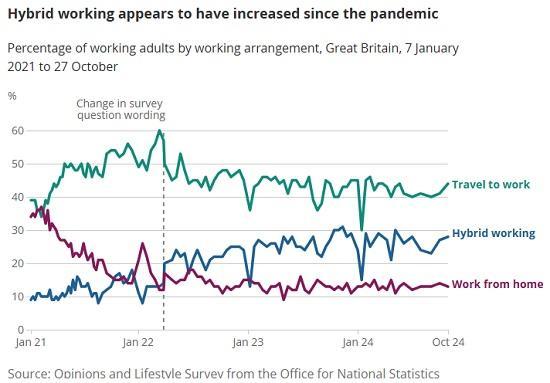Who Are The Hybrid Workers?
11th November 2024

Almost five years after the start of the COVID-19 pandemic, we look at the types of workers most likely to be following a hybrid working pattern - and how they spend their time.
More than a quarter of working adults in Great Britain (28%) were hybrid working in the autumn of 2024.
That's from our Opinions and Lifestyle Survey, which asks adults about their well-being and working patterns, from data collected between 2 and 27 October 2024.
We use this survey to monitor how people worked during and after coronavirus (COVID-19) restrictions.
While the trend in working only from home has fallen since 2021, a hybrid-working model (part travelling to work, and part at home), has become the ‘new normal' for around a quarter of workers.
In 2022, we asked the question, ‘is hybrid working here to stay?'. It appears it is, but for some workers more than others.
Looking over a longer time (from April 10 to 30 June 2024) allows us to see more details about who tends to follow these working patterns.
During this period hybrid working was more common among those aged over 30 years, parents, those working as managers or professionals, and those in industries that require less face-to-face contact. Those with higher qualifications were also more likely to hybrid work.
Combining data across different sources shows us a broad picture of who is likely to hybrid work and who is not, and clues as to why this method of work has persisted.
More time spent on rest, exercise and well-being when working at home
Those working from home saved an average of 56 minutes that day from not commuting, according to our Time Use Survey.
Findings from March 2024 suggest that some of that time was spent on rest, exercise, sports and well-being.
Respondents who worked from home on a given day spent an average of 24 minutes more on ‘sleep and rest' and 15 minutes more on ‘exercise, sports and well-being' on the respective day compared with those who worked away from home.
'Improved staff well-being' has continued to be one of the most frequently reported business reasons for using or intending to use increased hybrid- and home-working, according to our Business Insights and Conditions Survey.
Although there was a slight drop in the average amount of time people working at home said they spent working (10 minutes fewer), we can't say if this is just down to chance in who was surveyed. Our estimates for time spent working aren't precise enough to be sure. We also can't say from this data how time use affects work productivity.
We know some groups of people are more likely to follow homeworking or hybrid working arrangements, which could contribute to time spent on different activities.
Managers, parents and over 30s are more likely to hybrid work
Workers aged over 30 years were more likely to hybrid work compared with those in their 20s and younger.
Of people surveyed between April 10 and 30 June 2024, 29% of workers aged 30 years and older followed a hybrid working pattern, compared with 19% for those aged 16 to 29 years old, according to the Opinions and Lifestyle Survey.
Those over 30 years old are more likely to be parents, and to hold managerial positions, both of which may make someone more likely to be a hybrid worker.
We also know from the census that young people aged 16 to 24 years are more likely to have jobs in hospitality and retail, particularly in customer-facing roles that have to be in person, such as waiting or bar work.
Working parents were more likely to hybrid work (35%) compared with working non-parents (24%). This may be because parents find hybrid working helps to facilitate childcare or working around the school day.
Our data did not consider people who have other unpaid care responsibilities, such as caring for an elderly relative or another adult. It’s possible this group would also have a preference for hybrid working as a form of flexible working.
Male working parents were more likely to hybrid work than female working parents (41% compared with 30% respectively).
Close to half (45%) of those in more senior occupations (shown in the chart below as ‘managers, directors and senior officials’) followed a hybrid working model, compared with 27% of all workers. That compares with just 3% of people working in sectors such as working on the shop floor in retail or cleaning services (‘elementary occupations’) and 3% of people working in ‘caring, leisure and other services’.
Managers and directors may be more likely to be able to carry out desk-based work remotely, even in high-contact industries. For example, a senior manager in a retail company may have more desk-based work while more junior staff in the same company may need to be working in the shops themselves.
Workers in ‘professional occupations’ were also more likely to hybrid work.
Read h full article with may links and graphs HERE
